We have unearthed this article pertaining to What To Do And What Not To Do When Dealing With Water Damage directly below on the internet and think it made perfect sense to share it with you on my blog.

What should you do if a pipes bursts in your home, creating a mini-waterfall as well as swamping an area of your residence? In this situation, you should act fast. The longer you wait, the more extreme the water damages in your residential or commercial property. When an emergency similar to this happens, clearheadedness is essential. For these reasons, you need to discover what to in case of a ruptured pipes. Due to the fact that time is of the significance, examine out the complying with pointers listed below to aid you act quickly.
Turn off the Main Waterline Valve
The first thing you have to do is close the shut-off shutoff. Seek the neighborhood shut-off shutoff to turn-off water in one specific area only. If you don't recognize where the localized shut-off shutoff to the fixture is, you need to turn-off the major waterline valve. This will certainly cut off the water in your whole house. Usually, the major shutoff is discovered outside the home alongside the water meter. You can additionally discover it in the cellar at an eye-level or it might be in the 1st flooring on the ground if it's not there. Usually, builders however the shut-off shutoff generally ground degree washroom or ideal next to it.
Call Water Damage Reconstruction Pros for Assistance
After shutting the water resource, call the pros for help. This is not something you can conveniently DIY because they require to fix the pipes and also address the damages to your residential property. Seek assistance from a respectable business offering 24/7 emergency services. With their professional aid, you can reduce exacerbation since water can leak via your things leading to deformed baseboards, loose floor tiles, or damage structure. Do not take this problem lightly as well as look for career guidance for total satisfaction.
Paper the Damages For Insurance
As you are awaiting the pros to show up, document the damage triggered by the wayward pipeline. Take images and videos of everything. Do closeup shots of belongings. These points will certainly act as proof for your homeowner's insurance. Staying positive with this allows you to sue for insurance coverage, which will certainly help you and your family come back on your feet.
Recover Points That Can Be Saved
When you're done taking photos, browse the items and take out one of the most vital ones from the pile. Dry them off and attempt to preserve as high as you can. Drag them far from wetness so they can begin to dry out.
Beginning the Drying Refine
Luckily, water from your waterlines are clean so you do not have to worry concerning drain water. The moving water may have interrupted the dust and debris in your carpetings as well as floorboards. Be prepared with handwear covers as you use containers to dump out the water.
Specialists are the only ones certified to fix the burs pipelines and subsequent damages. And keep in mind, pipes don't simply suddenly burst. You will generally see red flags like bubbling paint, odd sounds in the plumbing, musty smell, caving ceiling, peeling off wallpaper, or water stains. Take notice of these things, so you can nip any type of concerns in the bud.
What should you do if a water pipeline ruptureds in your residence, creating a mini-waterfall and flooding an area of your house? For these factors, you require to discover what to in instance of a ruptured water pipeline. After shutting the water source, call the pros for aid. With their expert help, you can mitigate exacerbation since water can leak through your things resulting in distorted walls, loosened floor tiles, or damages framework. Thankfully, water from your waterlines are clean so you don't have to worry about sewer water.
How to Handle a Burst Pipe and Minimize Damage
Steps to Take Ahead of Time
If you own property in an area that experiences cold weather, you need to be aware of seasonal maintenance tasks that will help you protect your property as the weather changes each year. One of the most important steps is to winterize your pipes to ensure they won't freeze or burst when the temperature drops. This includes action items like insulating any exposed pipes, detaching garden hoses and covering outdoor faucets. If the weather gets cold enough, you may even consider leaving a faucet dripping or opening cabinet doors during the coldest parts of the day.
No matter how prepared you might be, accidents and emergencies still happen. You'd be wise to set up a savings account specifically for your property so you have a "rainy day" fund set aside for unexpected expenses. All homes regardless of age, location or condition will inevitably need some form of emergency repair.
Steps to Take for Frozen Pipes
A frozen pipe will not necessarily burst, so if you can catch a frozen pipe early on, you could save yourself a major headache. When your area experiences frigid temperatures, be sure to check your plumbing and keep an eye out for warning signs like faucets only releasing small amounts of water or toilets not refilling when flushed. If you do run into one of these issues, you're likely dealing with a frozen pipe.
If this happens, your first step should be to cut off the water supply to that section of the plumbing. Expanding and freezing water can quickly cause damage. Even if the water supply is shut off, you will likely still deal with some leaking from the water that defrosts after the pipe has thawed. Be prepared with a mop, bucket and/or towels to quickly soak up any excess water.
In order to thaw a frozen pipe, you can use a space heater, infrared or incandescent heat lamp, or even a hairdryer to warm up the frozen area. Heat tape is also an option and should be used according to manufacturer instructions. Do not use any sort of open flame to thaw frozen pipes, as it poses a major fire hazard and can damage your pipes further.
Steps to Take for a Burst Pipe
Water damage claims are the second most common insurance claim in the U.S. When you're dealing with a frozen pipe, the water continues to expand as it freezes, which creates pressure that can cause a pipe to burst. When this happens, the crack or leak in the pipe allows water flow from the pipe to enter your home where it shouldn't. If a pipe does burst, you need to act quickly to mitigate property damage and repair cost.
- Your very first step should be to shut off your main water supply to minimize flooding typically the most expensive damage to address.
- Once you've shut off the water supply, make sure you identify the entire area that has been impacted by the leak. Remove as much water as possible as quickly as possible using a mop, sponges, towels or a shop vacuum or wet/dry vacuum.
- To prevent long-term damage due to moisture build-up, run a dehumidifier or fan in the affected area.
- Contact a licensed plumber to ensure the pipe is correctly repaired before running any water to that section of the home again.
Burst pipes and the associated water damage are something you absolutely want to avoid as a property owner. If you've had to learn your lesson the hard way, don't let yourself get caught in a similar situation during the next spell of cold weather. The best way to deal with frozen or burst pipes is to prevent them in the first place proactive winter maintenance will save you time, money and a whole lot of stress.

Do you really like more info about Rules For Handling Water Damage? Put a remark below. We'd be glad to find out your thoughts about this piece. We hope to see you back again soon. Sharing is caring. Helping others is fun. We take joy in reading our article about Do s And Don ts For Homeowners Managing With Water Damage.
Trust us, dial!
Comments on “Minimizing Water Damage Caused By Leaking Pipeline Problems - Practical Solutions”